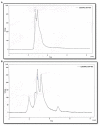AHL-Lactonase Producing Psychrobacter sp. From Palk Bay Sediment Mitigates Quorum Sensing-Mediated Virulence Production in Gram Negative Bacterial Pathogens
- PMID: 33935995
- PMCID: PMC8079732
- DOI: 10.3389/fmicb.2021.634593
AHL-Lactonase Producing Psychrobacter sp. From Palk Bay Sediment Mitigates Quorum Sensing-Mediated Virulence Production in Gram Negative Bacterial Pathogens
Abstract
Quorum sensing (QS) is a signaling mechanism governed by bacteria used to converse at inter- and intra-species levels through small self-produced chemicals called N-acylhomoserine lactones (AHLs). Through QS, bacteria regulate and organize the virulence factors' production, including biofilm formation. AHLs can be degraded by an action called quorum quenching (QQ) and hence QQ strategy can effectively be employed to combat biofilm-associated bacterial pathogenesis. The present study aimed to identify novel bacterial species with QQ potential. Screening of Palk Bay marine sediment bacteria for QQ activity ended up with the identification of marine bacterial isolate 28 (MSB-28), which exhibited a profound QQ activity against QS biomarker strain Chromobacterium violaceum ATCC 12472. The isolate MSB-28 was identified as Psychrobacter sp. through 16S-rRNA sequencing. Psychrobacter sp. also demonstrated a pronounced activity in controlling the biofilm formation in different bacteria and biofilm-associated virulence factors' production in P. aeruginosa PAO1. Solvent extraction, heat inactivation, and proteinase K treatment assays clearly evidence the enzymatic nature of the bioactive lead. Furthermore, AHL's lactone ring cleavage was confirmed with experiments including ring closure assay and chromatographic analysis, and thus the AHL-lactonase enzyme production in Psychrobacter sp. To conclude, this is the first report stating the AHL-lactonase mediated QQ activity from marine sediment bacteria Psychrobacter sp. Future work deals with the characterization, purification, and mass cultivation of the purified protein and should pave the way to assessing the feasibility of the identified protein in controlling QS and biofilm-mediated multidrug resistant bacterial infections in mono or multi-species conditions.
Keywords: AHL-lactonase; Pseudomonas aeruginosa; Psychrobacter sp.; marine Palk Bay sediment; quorum quenching.
Copyright © 2021 Packiavathy, Kannappan, Thiyagarajan, Srinivasan, Jeyapragash, Paul, Velmurugan and Ravi.
Conflict of interest statement
The authors declare that the research was conducted in the absence of any commercial or financial relationships that could be construed as a potential conflict of interest.
Figures






Similar articles
-
AidB, a Novel Thermostable N-Acylhomoserine Lactonase from the Bacterium Bosea sp.Appl Environ Microbiol. 2019 Nov 27;85(24):e02065-19. doi: 10.1128/AEM.02065-19. Print 2019 Dec 15. Appl Environ Microbiol. 2019. PMID: 31604771 Free PMC article.
-
Quorum-Quenching Bacteria Isolated From Red Sea Sediments Reduce Biofilm Formation by Pseudomonas aeruginosa.Front Microbiol. 2018 Jul 17;9:1354. doi: 10.3389/fmicb.2018.01354. eCollection 2018. Front Microbiol. 2018. PMID: 30065702 Free PMC article.
-
Mining Marine Metagenomes Revealed a Quorum-Quenching Lactonase with Improved Biochemical Properties That Inhibits the Food Spoilage Bacterium Pseudomonas fluorescens.Appl Environ Microbiol. 2022 Feb 22;88(4):e0168021. doi: 10.1128/AEM.01680-21. Epub 2021 Dec 15. Appl Environ Microbiol. 2022. PMID: 34910563 Free PMC article.
-
Quenching of acyl-homoserine lactone-dependent quorum sensing by enzymatic disruption of signal molecules.Acta Biochim Pol. 2009;56(1):1-16. Epub 2009 Mar 17. Acta Biochim Pol. 2009. PMID: 19287806 Review.
-
Quorum quenching: role in nature and applied developments.FEMS Microbiol Rev. 2016 Jan;40(1):86-116. doi: 10.1093/femsre/fuv038. Epub 2015 Oct 1. FEMS Microbiol Rev. 2016. PMID: 26432822 Review.
Cited by
-
Quorum Sensing: Not Just a Bridge Between Bacteria.Microbiologyopen. 2025 Mar;14(1):e70016. doi: 10.1002/mbo3.70016. Microbiologyopen. 2025. PMID: 40159675 Free PMC article. Review.
-
Marine Bacterial Secondary Metabolites: A Treasure House for Structurally Unique and Effective Antimicrobial Compounds.Mar Drugs. 2021 Sep 23;19(10):530. doi: 10.3390/md19100530. Mar Drugs. 2021. PMID: 34677431 Free PMC article. Review.
-
Anti-Biofilm Strategies: A Focused Review on Innovative Approaches.Microorganisms. 2024 Mar 22;12(4):639. doi: 10.3390/microorganisms12040639. Microorganisms. 2024. PMID: 38674584 Free PMC article. Review.
-
Nasal pathobiont abundance does not differ between dairy cattle with or without clinical symptoms of bovine respiratory disease.Anim Microbiome. 2025 Feb 18;7(1):16. doi: 10.1186/s42523-025-00382-3. Anim Microbiome. 2025. PMID: 39966965 Free PMC article.
-
Isolation and Characterization of Probiotic Bacteria from Traditional Foods.Appl Biochem Biotechnol. 2025 Apr;197(4):2197-2215. doi: 10.1007/s12010-024-05125-9. Epub 2024 Dec 23. Appl Biochem Biotechnol. 2025. PMID: 39714558
References
-
- Babu T. G., Nithyanand P., Babu N. K. C., Pandian S. K. (2009). Evaluation of cetyltrimethylammonium bromide as a potential short-term preservative agent for stripped goat skin. World J. Microbiol. Biotechnol. 25, 901–907. 10.1007/s11274-009-9969-6 - DOI
-
- Carlier A., Uroz S., Smadja B., Fray R., Latour X., Dessaux Y., et al. . (2003). The Ti plasmid of Agrobacterium tumefaciens harbors an attM-paralogous gene, aiiB, also encoding N-acyl homoserine lactone lactonase activity. Appl. Environ. Microbiol. 69, 4989–4993. 10.1128/aem.69.8.4989-4993.2003, PMID: - DOI - PMC - PubMed
LinkOut - more resources
Full Text Sources
Other Literature Sources
Molecular Biology Databases

